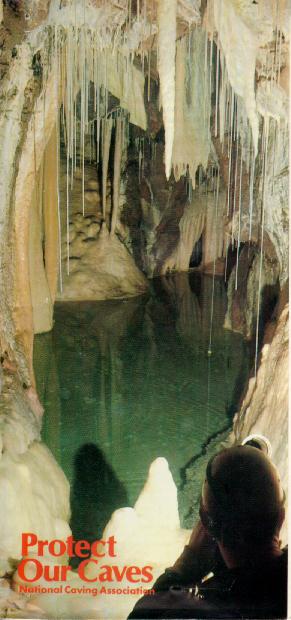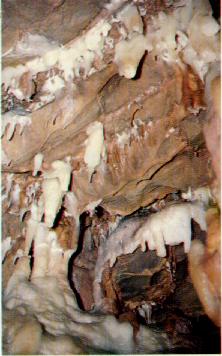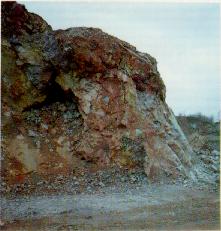 |
|
Protect Our Caves
Caves are a unique and very special part of our natural environment. Because of their slow and gradual formation over many thousands of years, fantastic passage shapes develop, breakdown occurs, sediments are deposited, beautiful calcite formations build up, and various creatures find a home. To be the first to enter such a place is an experience unlikely to be forgotten but unfortunately one that only a few people will be privileged to have.
Once a cave has been entered a process of deterioration begins. Sometimes this is extremely rapid but usually it is steady and barely noticeable. Whatever happens, the end result is the same, a place retaining little aesthetic value and interest. Such destruction is a crime against nature and there is a moral responsibility on the part of everyone using this environment for their enjoyment, whatever their motivation and purpose to ensure its preservation for others.

Why do people go caving? Initially perhaps for the simple experience of entering an unknown and hostile environment. Why they continue is not so simple to appreciate. Some continue for the sport alone, others to pursue a specific scientific interest, but for most it is a combination of many things. The majority of cavers have a purely sporting interest, but a large part of the enjoyment obtained on a trip underground is as a direct result of the type of passage being traversed and the features that can be seen en route. The maintenance of these features in as near natural state as possible is what conservation is about. Their deterioration can only detract from the pleasure of going underground.
The viewing of formations is one of the most rewarding experiences in a cave. Over many thousands of years the gradual build up of calcite develops beautiful shapes that often defy description. Many of these features are of great importance to cave scientists, who are able to deduce the evolutionary history of cave systems by analysing the formations which occur within them. Damaging or removing such features is like tearing out a page from a historic document. Yet these fragile formations are very susceptible to damage, and their beauty can be permanently spoilt by the touch of a dirty hand. Unfortunately, formations are often in close proximity to passers-by and damage, both intentional and accidental, does occur. As a solution, formations are often taped off and these tapes must never be crossed. Where tapes are not in place special care is required and it should always be remembered that a moments thoughtlessness may deprive someone else of the pleasure of seeing what once was there.
Tapes are installed to protect not only formations but also other features. Often, cave mud and floor deposits are of even greater value to cave scientists than are the more visually spectacular calcite formations. Their preservation is therefore equally vital. The trend in new discoveries is to tape a narrow pathway and restrict movement within this. This ensures the preservation of mud banks and other floor deposits, and ensures minimum disturbance of cave life. Visitors are allowed to see the cave in as near a natural state as possible and can then appreciate the damage done in other, unprotected systems by the passage of many thousands of trampling feet.
In all intensively used caves litter is a major problem. Regular clean-ups of some sites involve the removal of huge amounts of rubbish ranging from chocolate wrappers and ripped clothes, to dead batteries and spent carbide. It takes no real effort on the part of an individual to take out of the cave what he takes in, and little extra effort to take out someone else's rubbish. Litter of any form is unsightly, and in extreme cases can make going underground unpleasant. In addition, spent carbide and items that decompose, can cause pollution and harm cave life. This is a special problem since dumped carbide is difficult to remove, and its use is being banned in an increasing number of caves.
The unique environment of caves provides a habitat for many specialised life forms which are very susceptible to human disturbance. To the untrained observer bats are the most obvious life form found underground. All species of bat ore endangered and protected by law, and great care should always be taken not to disturb them, especially during the hibernating season from October to March, as this may result in their death. If you see a bat, pass by quickly and quietly. More abundant than bats, but less noticeable, are the numerous other creatures that live throughout the cave on the floor and in pools of water. These tiny animals are adapted to living in this hostile environment and are part of a delicately balanced ecosystem. The less disturbance that man causes, the more chance they have of survival.
Because their climatic conditions are constant, caves are excellent sites for the preservation of archaeological and palaeontological remains. The excavation of these, and their study, has revealed much about early man. Fortunately most of the material is buried in sediments in entrances and is unlikely to be disturbed except by digging. There are, however, a few sites where, for instance, bone stacks are found unburied. Anyone discovering remains, however seemingly insignificant, should not disturb them, and should seek expert advice immediately. A number of the more important sites where finds have been made have been scheduled as Ancient Monuments by the Department of the Environment.
Photography has an important role to play in conservation. It can increase awareness of the beauty of caves, and demonstrate the destruction from which they suffer. Unfortunately it can also pose a threat, and even reputable photographers have taken, and have had published, pictures demonstrating poor conservation practice. Additionally, photographers and their models have caused damage in their eagerness to obtain a better picture. The taking of photos is rewarding, but special care is essential owing to the close proximity to formations that is invariably involved. Always bear this in mind. Never cross tapes, watch yourself and your model at all times, and take pictures of damaged formations as well as others to demonstrate the need for conservation.
It is commonly thought that these activities are the realms of experienced cavers alone. This is not the case since most people have a desire to see what lies around the corner. This need not be discouraged but requires appropriate care. If exploration of a side passage may cause damage, first consult someone with a knowledge of the cave to find out if it has already been investigated. If starting a new dig, keep it tidy and avoid carrying mud on your clothing through the rest of the cave. If it seems necessary to break formations to continue, remember that they cannot be replaced; see if you can find an alternative route. Finally, if you find something, explore carefully and tape as necessary immediately. If in doubt seek the help of others with appropriate experience.
In the past it was common practice to place artificial aids in caves, but over the years these have been progressively removed. New ones should be installed only if absolutely essential. In recent years with the increased usage of Single Rope Techniques we are presented with another problem, the proliferation of bolts and anchors appearing at the heads of pitches. These can be very unsightly and even dangerous, as excessive numbers can weaken the rock. Wherever possible, natural belays should be used; additional bolts should never be installed where existing ones are adequate.
It is widely accepted that the deterioration of a cave is directly related to the number and type of visitors it receives. Usage is continually rising and a large proportion of these visitors originate from the military, outdoor centres, schools etc. Unless these groups are made more aware of the impact of their activities this trend is likely to continue, with the even more rapid deterioration of our caves. It is therefore vital that adequate supervision is provided for such parties and that they use sites of the lowest conservation interest.
Most caves have specific access requirements, ranging from asking the landowner through to the need to obtain a leader. The reasons for these restrictions vary; the landowner may require them, quite apart from any need to control access for conservation purposes, or they may be for conservation reasons alone. There is always considerable debate regarding this subject, but it can be guaranteed that invariably where there is some form of access control there is good reason for it. Failure to comply with these requirements can lead to a loss of access for everyone or to the destruction of some valuable feature. Details of access requirements can be found in the local guidebooks and the handbooks of the Regional Caving Councils.
A national Adopt-A-Cave scheme whereby clubs volunteer their services to look after specific caves has been initiated. The responsibilities include keeping the cave clean, as well as monitoring and reporting on damage. The scheme is very informal. Lists of caves covered by it are regularly published in the magazine Descent, and clubs are invited to join by informing the Editor of the sites they wish to look after.

There are a number of activities carried out on the surface by non-cavers that can threaten a cave, the most serious being quarrying, which can often completely destroy a cave system. Gripping of open moorland and afforestation can also have dramatic effects, such as increased flood flows, erosion of sediments and the deposition of silt and vegetable matter. Land reclamation for agricultural and other purposes can lead to the blocking of entrances, as can indiscriminate tipping. The tipping of anything but inert material can result in pollution which can harm or destroy cave life and prove a danger to cavers. Silage effluent from farms can have similar effects. Anyone learning of any of these problems should immediately bring them to the attention of the NCA or a Regional Caving Council, especially if the cave is an SSSI or NNR.
Many caves are given some form of statutory protection, either by being notified as a Site of Special Scientific Interest (SSSI) or as a National Nature Reserve (NNR). SSSI's are so designated by the Joint Nature Conservation Committee (JNCC) on behalf of the individual country conservation agencies English Nature, Countryside Council for Wales and Scottish Natural Heritage, who have a responsibility under the Wildlife and Countryside Act 1981 to safeguard them from specified damaging activities. There are 48 cave SSSI's in Britain, many of which are areas covering a number of individual sites.
Amended 1997. Originally published as a leaflet by the National Caving Association in 1986 with grant aid from the Nature Conservancy Council (since replace by JNCC, EN, CCW, SNH) and the World Wildlife Fund. Photos: N. Chipchase, G. Price.